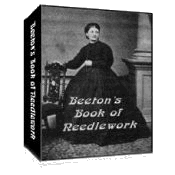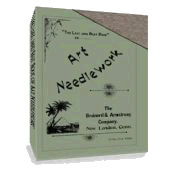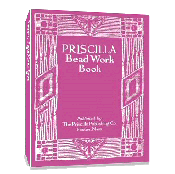Borders and Insertions
Borders and Insertions can take a drab, ho-hum article and make it look better. They can take a nice item and make it spectacular! It is often said that it's the details that count. In embroidery it is especially so.
By taking time to learn and use the information that follows, you will no longer be making "home made" pieces, you will be making DESIGNER pieces.
Embroidered Borders and Insertions.
Excerpt from Beeton's Book of Needlework, edited.
ILLUSTRATIONS Border No. 1 & Border No. 2 (Narrow Borders).--It will be easy to work these borders from the above instructions. Observe only that on border 1 the outer row of scallops is worked first, then the button-hole stitch row, and the rest afterwards. The spots are edged all round in knotted stitch.
The wheels in the centre of the eyelets of No. 2 are worked with very fine cotton in loose button-hole stitch; they are wound round with the cotton in a second row.


ILLUSTRATIONS Insertion No. 1 to Insertion No. 3.--Three strips of insertion, which are worked nearly like the ladder stitch.
For No. 1. - In tracing the outlines, make two small knots at short distances by winding the cotton four times round the needle, as can be seen in illustration; the windings are held down with the thumb of the left hand, draw the needle through, and a knot is formed. The outlines are worked in button-hole stitch only when all the knots have been made, and then the material is cut away underneath.
Illustration 2 is a variety of the slanting ladder stitch.
Illustration 3.-The cross threads are worked in two rows in the common herring-bone stitch, as can be seen by the black lines on the illustration. The straight lines at the top and at the bottom are worked in double overcast; lastly, the wheels are worked in a row as described for the star pattern, below.

ILLUSTRATION 104 (Star Pattern in Satin Stitch).--The centre, which forms a wheel, is worked first. Draw the threads across the circle marked by an outline; in the centre they are wound round, always taking one thread on the needle and leaving the next thread under the needle. The material underneath the wheel is only cut away when the rest of the pattern has been embroidered.
Care must be taken when producing borders and insertions. They are often what draws the eye to the item. If done carelessly, flaws will be seen quickly.
Such decorative pieces can be time consuming but what a difference they make to your finished item!
Return to top of Borders and Insertions, page.
The Last and Best Book of Art Needlework
Over 100 pages of authentic Victorian instructions and patterns from 1895!
FREE
Beeton's Book Of Needlework

433 pages!
Sign up for VEAC! Everything you wanted to know about Victorian embroidery, needlework, crafts and more!
Priscilla Bead Work Book
Make Beautiful Victorian Beaded Purses, Jewelry & Accessories - Starting
TODAY!



